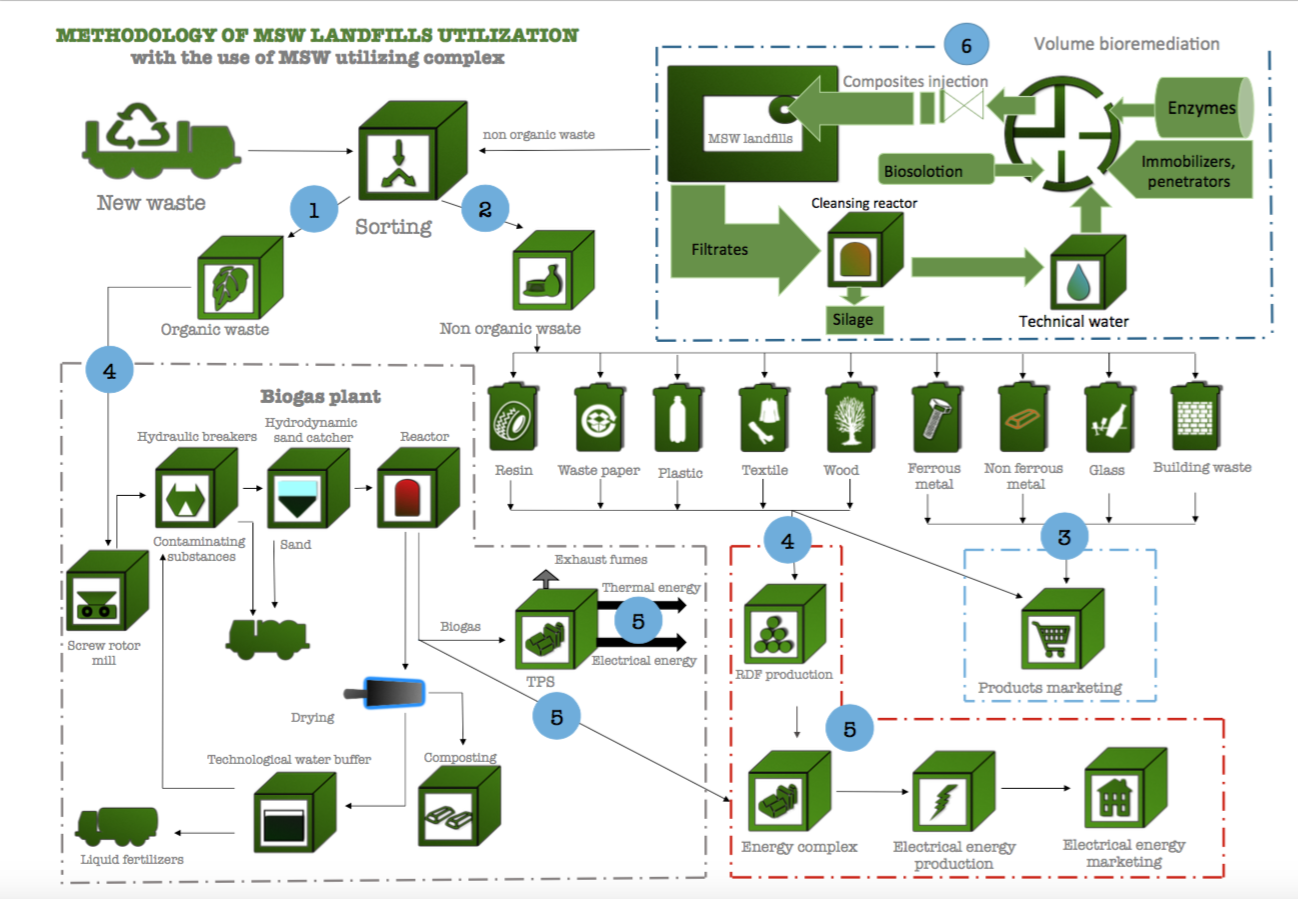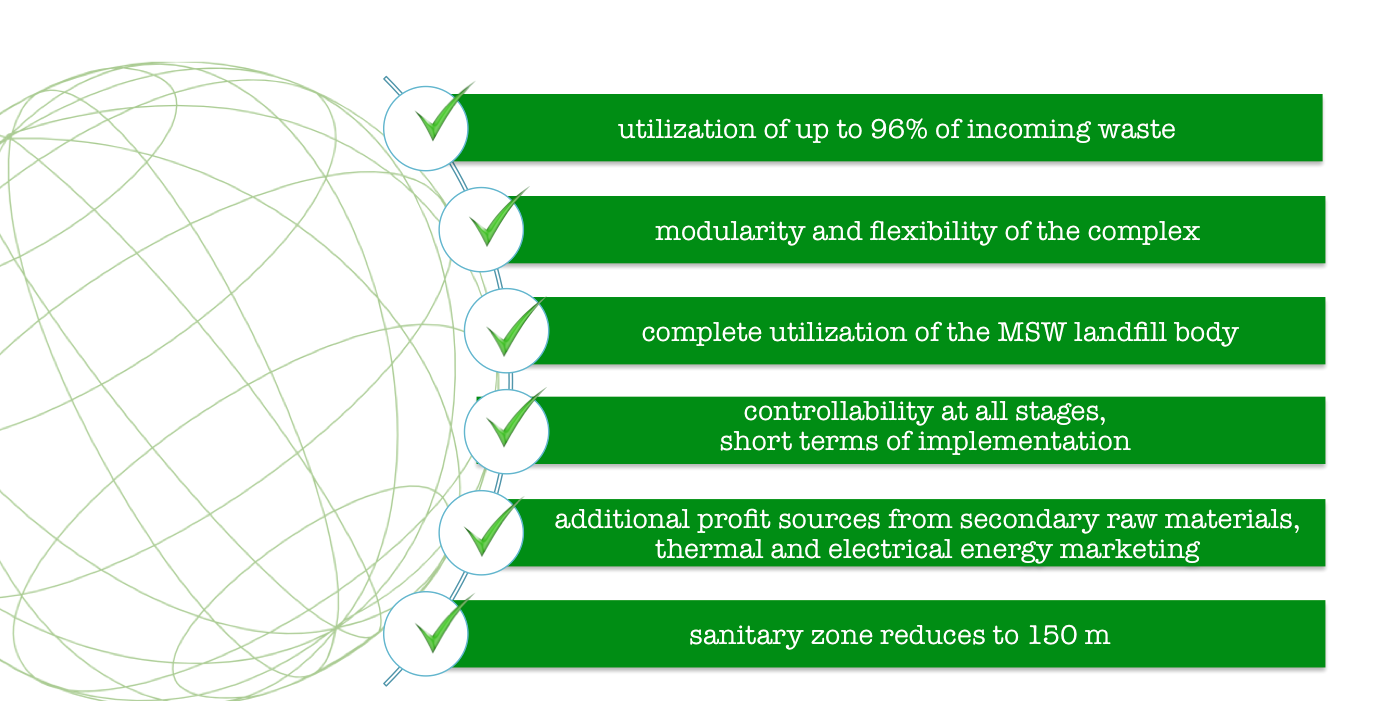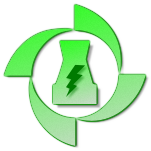SEMI-AUTOMATIC SORTING
- organic matter separation
- non-organic matter sorting
At this stage, an automatic separation of the organic matter of incoming waste takes place. At the next stage, biogas is produced from separated organic matter. Also, optionally, a variant of fertilizers production for own needs or for sale is offered.
The non-organic matter of waste is sorted manually into the following components for recycling: plastics, food-grade aluminum, glass, waste paper etc. Received secondary raw material is sent to the press-packing unit for further processing or sale.
BIOTECHNOLOGICAL PROCESSING
- biofuel production
- organic-humus fertilizers production
The main macro-components of gas formed during the decomposition of organic garbage in landfills are methane (CH4) and carbon dioxide (CO2). Each ton of organic garbage can give 300 to 800 m3 of biofuel. Biofuel is a mixture of methane, carbon dioxide, nitrogen and water vapor. Such biofuel is used for obtaining heat and electricity from it and for its subsequent sale on the terms of the Green Tariff and use for own needs.
Organic-humus fertilizers that are produced as a by-product of methane digestion of a biogas plant do not contain pathogenic organisms and weed seeds and can be used both for own needs and for sale.
SECONDARY RAW MATERIAL PRODUCTION
- non-organic waste sorting
- press-packing
After manual sorting, residual non-organic waste is passed through magnetic and non-magnetic detectors, vibration sieve, to separate ferrous and non-ferrous metals, solid minerals. All types of received secondary raw materials are gradually reduced to a fraction of 10-50 mm (depending on the requirements of the Customer), washed, pressed and packed in bales for the purpose of further re-sale, sale or use for own needs.
ENERGY PRODUCTION
- Thermal energy
- Electrical energy
- Thermal and electrical energy
The energy generating complex is the main production unit of this methodology. Its presence in the configuration of the integrated waste recycling and utilization plant allows to solve the following tasks:
- Performs the function of a co-generation unit in the production of biogas;
- Generates thermal energy for the production of compost;
- Carries out the utilization of all combustible components of solid waste (except hazardous waste);
- Генерує теплову енергію для виготовлення компосту;
- Виконує утилізацію всіх горючих складових ТПВ (окрім небезпечних відходів);
RDF FUEL PRODUCTION
- primary RDF fuel
- RDF fuel
Primary RDF fuel - residual waste after all stages of sorting, which is not subject to recycling. Usually - up to 50% of all garbage. RDF fuel is obtained in the way of shredding, separating, removing of contaminating elements and further dehydrating of the primary RDF fuel. The resulting RDF fuel is used for the production of heat and electricity and their subsequent sale under the terms of Green Tariff and use for own needs.
VOLUME BIOREMEDIATION
- utilization of organic matter of MSW landfill without excavation
- complete utilization of the MSW landfill body
Volume bioremediation - a method of MSW landfills utilization through a three-stage process, which at the first stage includes installation of perforated pipes connected into a system of vertical perforated sections of pipes, where through biologics are feeded for disinfection and destroy of waste organic matter without excavation; at the second stage, metal, glass, stones, the residual of building materials are sorted and transported for further processing; at the third stage, the landfill is compressed and covered with a layer of soil. Enzymes that are fed under pulsating pressure are used as biologicals and perforated vertical pipe areas are chessed among the body of the landfill.


This methodology provides for the modularity of the entire system. The "modular principle" is at the heart of the methodology and allows its expansion, reorientation, improvement etc. In addition, such an approach allows the formation of such a technological process, which takes into account characteristics of MSW morphology in the region, market of secondary raw materials, energy needs and energy distribution modes.
Technology includes:
- Sorting
- Organic matter utilization in the way of:
- fertilizers production,
- biogas production with a further production of fertilizers from biogas by-products;
- Complete selection of secondary raw materials for sale;
- Production of high-calorie RDF fuel;
- Production of heat and/or electric energy;
- Final stage - conducting volumetric bioremediation in the body of the MSW landfill, further sorting of garbage and complete utilization of the MSW landfill body.
- Use or sale of lands after their recultivation and reduction of the sanitary zone to 150 meters.
While developing this methodology we were guided by the following regulatory documents.
ADVANTAGES OF THE METHODOLOGY
____________________________________ _______________________________________________
_______________________________________________







